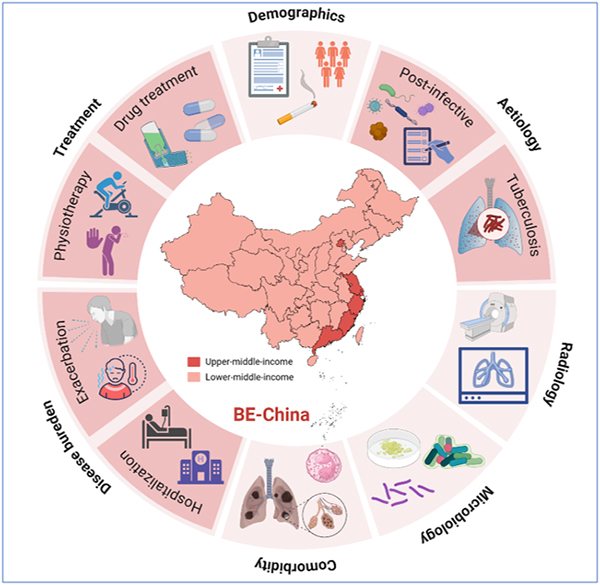

Characteristic Map of Chinese Branch Expansion Patients
With the support of National Natural Science Foundation of China projects
(approval numbers: 81925001, 82330070) and other grants, the team of Professor
Xu Jinfu from Fudan University Affiliated East China Hospital/Tongji University
Respiratory Disease Research Institute, and Professor Qu Jieming from Shanghai
Jiao Tong University School of Medicine Affiliated Ruijin Hospital, together
with domestic and foreign scholars, have made progress in the clinical feature
map data of patients with bronchiectasis (referred to as bronchiectasis) in
China. The research findings were published on January 10, 2024 in The Lancet
Respiratory Medicine, under the title "Baseline characteristics of patients in
the Chinese Bronchiactasis Registry [BE China]: a multicenter prospective cohort
study". Paper link:
https://www.thelancet.com/journals/lanres/article/PIIS2213-2600
(24)00364-3/fulltext。
Bronchiectasis is a chronic airway disease, and its incidence rate is
increasing year by year. Branch expansion has the characteristics of long
disease course, significant symptoms, and easy recurrence of acute exacerbation.
However, currently there is limited understanding of the clinical
characteristics of Chinese patients with bronchiectasis, and there is a lack of
systematic collection and analysis of data on the population of bronchiectasis
patients. Clarifying the clinical characteristics and heterogeneity of Chinese
patients with bronchiectasis is a key issue in improving the standardized
diagnosis and treatment capabilities of bronchiectasis in China.
The research team collected clinical data from 10324 patients with branch
expansion from 97 centers and compared it with the characteristics of branch
expansion cohorts such as the European Branch Expansion Alliance. Research has
found that women account for a higher proportion of patients with bronchiectasis
in China and are more likely to develop cardiovascular disease and chronic
obstructive pulmonary disease. In terms of lung function, obstructive airflow
limitation is the main type, accounting for 42.8%. Etiological analysis shows
that infection is the most common factor leading to bronchiectasis, accounting
for 43.2%; Pseudomonas aeruginosa is the pathogen with the highest detection
rate, accounting for 20.8%. The imaging examination results showed that cystic
bronchiectasis was the most common manifestation, accounting for 37.4%. In
addition, the study also found that patients with branch expansion in low - and
middle-income areas have a heavier disease burden, higher rates of acute
exacerbation and hospitalization, and poorer quality of life.
This study established the Chinese Bronchiectasis Registry (BE China) and
drew a clinical characteristic map of bronchiectasis patients in China,
revealing their distinct regional features. The research results provide data
support for the precise diagnosis and treatment of branch expansion.